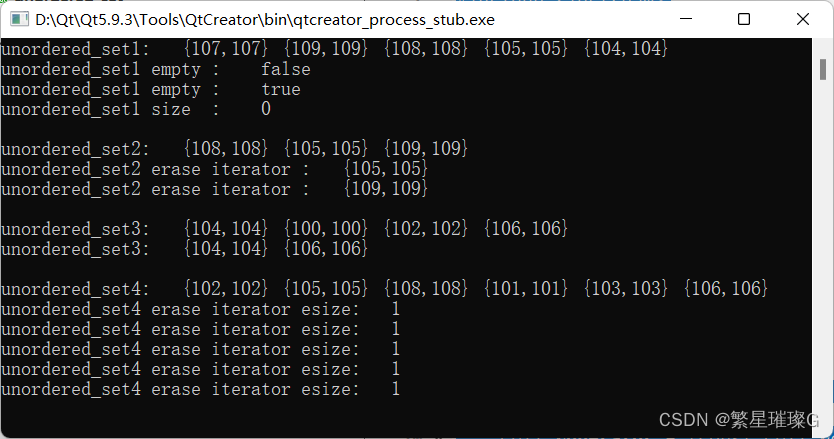c++11 标准模板(STL)(std::unordered_set)(八)
定义于头文件 <unordered_set>
| template< class Key, | (1) | (C++11 起) |
| namespace pmr { template <class Key, | (2) | (C++17 起) |
unordered_set is 是含有 Key 类型唯一对象集合的关联容器。搜索、插入和移除拥有平均常数时间复杂度。
在内部,元素并不以任何特别顺序排序,而是组织进桶中。元素被放进哪个桶完全依赖其值的哈希。这允许对单独元素的快速访问,因为哈希一旦,就准确指代元素被放入的桶。
不可修改容器元素(即使通过非 const 迭代器),因为修改可能更改元素的哈希,并破坏容器。
修改器
清除内容
std::unordered_set<Key,Hash,KeyEqual,Allocator>::clear| void clear() noexcept; | (C++11 起) |
从容器擦除所有元素。此调用后 size() 返回零。
非法化任何指代所含元素的引用、指针或迭代器。可能亦非法化尾后迭代器。
参数
(无)
返回值
(无)
复杂度
与容器大小,即元素数成线性。
缺陷报告
下列更改行为的缺陷报告追溯地应用于以前出版的 C++ 标准。
擦除元素
std::unordered_set<Key,Hash,KeyEqual,Allocator>::erase| iterator erase( const_iterator pos ); | (1) | (C++11 起) |
| iterator erase( const_iterator first, const_iterator last ); | (2) | (C++11 起) |
| size_type erase( const key_type& key ); | (3) | (C++11 起) |
从容器移除指定的元素。
1) 移除位于 pos 的元素。
2) 移除范围 [first; last) 中的元素,它必须是 *this 中的合法范围。
3) 移除关键等于 key 的元素(若存在一个)。
到被擦除元素的引用和迭代器被非法化。其他迭代器和引用不被非法化。
迭代器 pos 必须合法且可解引用。从而 end() 迭代器(合法,但不可解引用)不能用作 pos 所用的值。
| 保留未被擦除的元素顺序(这使得可能在迭代通过容器时擦除单独的元素)。 | (C++14 起) |
参数
| pos | - | 指向要移除的元素的迭代器 |
| first, last | - | 要移除的元素范围 |
| key | - | 要移除的元素关键值 |
返回值
1-2) 后随最后被移除的元素的迭代器。
3) 被移除的元素数。
异常
1,2) (无)
3) 任何 Compare 对象所抛的异常
复杂度
给定 unordered_set 的实例 c :
1) 平均情况:常数,最坏情况: c.size()
2) 平均情况: std::distance(first, last) ,最坏情况: c.size()
3) 平均情况: c.count(key) ,最坏情况: c.size()
调用示例
#include <iostream>
#include <forward_list>
#include <string>
#include <iterator>
#include <algorithm>
#include <functional>
#include <unordered_set>
#include <time.h>using namespace std;struct Cell
{int x;int y;Cell() = default;Cell(int a, int b): x(a), y(b) {}Cell &operator +=(const Cell &cell){x += cell.x;y += cell.y;return *this;}Cell &operator +(const Cell &cell){x += cell.x;y += cell.y;return *this;}Cell &operator *(const Cell &cell){x *= cell.x;y *= cell.y;return *this;}Cell &operator ++(){x += 1;y += 1;return *this;}bool operator <(const Cell &cell) const{if (x == cell.x){return y < cell.y;}else{return x < cell.x;}}bool operator >(const Cell &cell) const{if (x == cell.x){return y > cell.y;}else{return x > cell.x;}}bool operator ==(const Cell &cell) const{return x == cell.x && y == cell.y;}
};struct myCompare
{bool operator()(const int &a, const int &b){return a < b;}
};std::ostream &operator<<(std::ostream &os, const Cell &cell)
{os << "{" << cell.x << "," << cell.y << "}";return os;
}std::ostream &operator<<(std::ostream &os, const std::pair<const int, Cell> &pCell)
{os << pCell.first << "-" << pCell.second;return os;
}struct CHash
{size_t operator()(const Cell& cell) const{size_t thash = std::hash<int>()(cell.x) | std::hash<int>()(cell.y);
// std::cout << "CHash: " << thash << std::endl;return thash;}
};struct CEqual
{bool operator()(const Cell &a, const Cell &b) const{return a.x == b.x && a.y == b.y;}
};int main()
{std::cout << std::boolalpha;std::mt19937 g{std::random_device{}()};srand((unsigned)time(NULL));auto generate = [](){int n = std::rand() % 10 + 100;Cell cell{n, n};return cell;};std::unordered_set<Cell, CHash, CEqual> unordered_set1;//6) 插入来自 initializer_list ilist 的元素。若范围中的多个元素拥有比较等价的关键,则插入哪个元素是未指定的unordered_set1.insert({generate(), generate(), generate(), generate(), generate(), generate()});std::cout << "unordered_set1: ";std::copy(unordered_set1.begin(), unordered_set1.end(), std::ostream_iterator<Cell>(std::cout, " "));std::cout << std::endl;std::cout << "unordered_set1 empty : " << unordered_set1.empty() << std::endl;//从容器擦除所有元素。此调用后 size() 返回零。unordered_set1.clear();std::cout << "unordered_set1 empty : " << unordered_set1.empty() << std::endl;std::cout << "unordered_set1 size : " << unordered_set1.size() << std::endl;std::cout << std::endl;std::unordered_set<Cell, CHash, CEqual> unordered_set2;//6) 插入来自 initializer_list ilist 的元素。若范围中的多个元素拥有比较等价的关键,则插入哪个元素是未指定的unordered_set2.insert({generate(), generate(), generate(), generate(), generate(), generate()});std::cout << "unordered_set2: ";std::copy(unordered_set2.begin(), unordered_set1.end(), std::ostream_iterator<Cell>(std::cout, " "));std::cout << std::endl;size_t usize = unordered_set2.size();for (size_t index = 0; index < usize - 1; index++){//从容器移除指定的元素。1) 移除位于 pos 的元素。std::unordered_set<Cell, CHash, CEqual>::iterator rit = unordered_set2.erase(unordered_set2.cbegin());std::cout << "unordered_set2 erase iterator : " << *rit << std::endl;}std::cout << std::endl;std::unordered_set<Cell, CHash, CEqual> unordered_set3;//6) 插入来自 initializer_list ilist 的元素。若范围中的多个元素拥有比较等价的关键,则插入哪个元素是未指定的unordered_set3.insert({generate(), generate(), generate(), generate(), generate(), generate()});std::cout << "unordered_set3: ";std::copy(unordered_set3.begin(), unordered_set3.end(), std::ostream_iterator<Cell>(std::cout, " "));std::cout << std::endl;std::unordered_set<Cell, CHash, CEqual>::const_iterator bcit = unordered_set3.cbegin();bcit++;std::unordered_set<Cell, CHash, CEqual>::const_iterator ecit = bcit;ecit++, ecit++;unordered_set3.erase(bcit, ecit);std::cout << "unordered_set3: ";std::copy(unordered_set3.begin(), unordered_set3.end(), std::ostream_iterator<Cell>(std::cout, " "));std::cout << std::endl;std::cout << std::endl;std::unordered_set<Cell, CHash, CEqual> unordered_set4;//6) 插入来自 initializer_list ilist 的元素。若范围中的多个元素拥有比较等价的关键,则插入哪个元素是未指定的unordered_set4.insert({generate(), generate(), generate(), generate(), generate(), generate()});std::cout << "unordered_set4: ";std::copy(unordered_set4.begin(), unordered_set4.end(), std::ostream_iterator<Cell>(std::cout, " "));std::cout << std::endl;usize = unordered_set4.size();for (size_t index = 0; index < usize - 1; index++){//从容器移除指定的元素。3) 移除关键等于 key 的元素(若存在一个)。size_t esize = unordered_set4.erase(*unordered_set4.cbegin());std::cout << "unordered_set4 erase iterator esize: " << esize << std::endl;}std::cout << std::endl;return 0;
}输出

